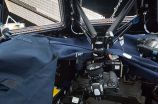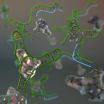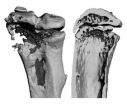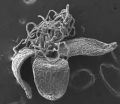HOUSTON, TX, February 14, 2013 (Press-News.org) There is a reason the phrase "shooting in the dark" refers to things that are difficult to do -- and night photography is no exception. To account for low-light image scenarios, a photographer needs a steady tripod, but aboard the International Space Station, a traditional tripod isn't going to cut it. Thankfully, the European Space Agency, or ESA, developed NightPod for the crew's cameras.
This astronaut photograph of Liege, Belgium, at night was taken using the NightPod camera mount aboard the space station. The mechanism allows astronauts to capture images of the Earth at night with greater clarity and control than previously possible from orbit.
"The challenges of low-light photography from orbit -- for example, the likelihood of blurry images because of the ground motion -- have always frustrated astronauts," said Cynthia Evans, International Space Station associate program scientist for Earth Observations. "Over the years, astronauts have experimented with different solutions, including high-speed films and manual tracking to compensate for the ground motion. The NightPod camera mount allows the crew to successfully track the Earth using low-light camera settings."
NightPod incorporates an ESA Nodding Mechanism, which is an electro-mechanical mount system for digital cameras designed to compensate for the motion of the station relative to the Earth. This high-tech, motorized tripod can compensate for the more than 17,000 mph (27,000 kph) speed of the station and the motion of the Earth below--no easy feat!
The crew enters the station's orbit and attitude into NightPod, enabling the instrument to automatically track a specific location on the ground and keep the target in frame for optimal focus. Since the system can be set to run automated for up to six hours, the crew can literally take pictures in their sleep.
To get an idea of just how clear images using NightPod are, look at how detailed the brightly lit core of the Liege urban area appears. It lies at the center of a network of roadways -- traceable by continuous orange lighting extending out into the rural and relatively dark Belgian countryside. For a sense of scale, the distance from image left to right is approximately 43 miles (70 kilometers). The region to the southeast of Verviers includes agricultural fields and forest; hence, it appears almost uniformly dark at night.
The image of Liege was acquired on Dec. 8, 2012, with a Nikon D3S digital camera using a 180 millimeter lens and the NightPod, and is provided by CEO investigators and the Image Science and Analysis Laboratory at Johnson Space Center. The image was taken by the Expedition 34 crew. It was cropped and enhanced to improve contrast, and lens artifacts were removed.
Installation of NightPod was completed on Feb. 24, 2012, by astronaut Andre Kuipers, and some of the earliest images appear in this ESA story. The primary goal of NightPod is to take high-resolution, long-exposure digital imagery of the planet from the station's Cupola, particularly cities at night. Other scenarios of interest include evening observations of brush fires, visual analysis of maritime and road traffic, volcano activity, urban pollution, squid fishing and day/night transitions.
"Nighttime imagery from orbit provides an instant understanding about humanity's footprint on the Earth's surface," Evans said.
While the official NightPod mission is done, the mechanism remains on station for astronauts to use as part of the Crew Earth Observations, or CEO, investigation. For CEO, the astronauts photograph natural and human-made events on Earth from the orbiting lab. The images record the ground's surface changes over time, atmospheric phenomena like aurora and polar mesospheric clouds, and dynamic happenings such as storms, floods, fires and volcanic eruptions. Together with automated remote sensing systems on the space station, handheld camera imagery provides researchers with data to understand the planet from an orbital perspective.
The International Space Station Program supports the imaging laboratory as part of the U.S. National Lab to help astronauts take pictures of Earth that will be of the greatest value to scientists and the public, and to make those photographs freely available on the Internet. Additional images taken by astronauts and cosmonauts can be viewed at the NASA/JSC Gateway to Astronaut Photography of Earth.
For more information on past, ongoing, and future ISS research activities, including research results and publications, visit:
http://www.nasa.gov/mission_pages/station/research/index.html
If you are interested in subscribing to updates from the ISS Program Science Office, visit:
https://lists.nasa.gov/mailman/listinfo/iss-program-science-group
For more information about the International Space Station, visit:
http://www.nasa.gov/station
NightPod Images Bring Earth to Light From Space Station
RELEASE: JR13-008
2013-02-14
ELSE PRESS RELEASES FROM THIS DATE:
The Container Store to Share Thousands of Hugs in Honor of "National We Love Our Employees Day"
2013-02-14
The Container Store (R), the nation's originator and leading retailer of storage and organization products, today honors its 6,000 employees across the country by celebrating its fourth annual "National We Love Our Employees Day (TM)." In 2010, the company proclaimed February 14 as its National We Love Our Employees Day to not only celebrate its own employee-first culture, but to also encourage other companies to do so.
Today's companywide celebration includes special "warm" surprises for every employee from Long Island to Los Angeles and even the ...
NE-WHERE Electronic Cigarettes Now Available at 7-Eleven Stores
2013-02-14
According to a spokesperson for NE-WHERE, the company's popular selling brand of electronic cigarettes are now available for purchase at local participating 7-Eleven stores. The well-established convenience store chain long known for its Big Gulp, will now also offer smokers this increasingly attractive alternative to traditional "tobacco" cigarettes.
This is definitely a coup for the high quality electronic cigarette maker with innovative packaging, which is now being sold at gas stations and drugstores across the western United States. All three popular flavors ...
Platelet-rich plasma treatment shows potential for knee osteoarthritis
2013-02-13
A study by researchers from Hospital for Special Surgery has shown that platelet-rich plasma (PRP) holds great promise for treating patients with knee osteoarthritis. The treatment improved pain and function, and in up to 73% of patients, appeared to delay the progression of osteoarthritis, which is a progressive disease. The study appears online, ahead of print, in the Clinical Journal of Sports Medicine.
"This is a very positive study," said Brian Halpern, M.D., chief of the Primary Care Sports Medicine Service at Hospital for Special Surgery, New York City, and lead ...
Detecting cocaine 'naturally'
2013-02-13
This press release is available in French.
Montréal, February 13, 2013 – Since the beginning of time, living organisms have developed ingenious mechanisms to monitor their environment. As part of an international study, a team of researchers has adapted some of these natural mechanisms to detect specific molecules such as cocaine more accurately and quickly. Their work may greatly facilitate the rapid screening—less than five minutes—of many drugs, infectious diseases, and cancers.
Professor Alexis Vallée-Bélisle of the University of Montreal Department of Chemistry ...
UTHealth: Alcohol consumption may be in response to smoking cessation
2013-02-13
HOUSTON – (Feb.12, 2013) – New findings by researchers at The University of Texas Health Science Center at Houston (UTHealth) School of Public Health may help identify situations in which smokers who are trying to quit are at a higher risk of relapse.
More than 1,200 people die in the United States every day from smoking-related illnesses. This is equivalent to three airplanes loaded with passengers crashing everyday in America. Smoking-related illnesses are the No. 1 cause of preventable deaths in the country, killing more Americans than drugs, homicides, suicides, ...
UCSB study of cocaine addiction reveals targets for treatment
2013-02-13
(Santa Barbara, Calif.) –– Scientists at UC Santa Barbara are researching cocaine addiction, part of a widespread problem, which, along with other addictions, costs billions of dollars in damage to individuals, families, and society. Laboratory studies at UCSB have revealed that the diminished brain function and learning impairment that result from cocaine addiction can be treated –– and that learning can be restored.
Karen Szumlinski, a professor in the Department of Psychological & Brain Sciences at UCSB, and her colleagues Osnat Ben-Shahar and Tod Kippin, have worked ...
Emerging cancer drugs may drive bone tumors
2013-02-13
Cancer drugs should kill tumors, not encourage their spread. But new evidence suggests that an otherwise promising class of drugs may actually increase the risk of tumors spreading to bone, according to researchers at Washington University School of Medicine in St. Louis.
The drugs, IAP antagonists, block survival signals that many cancer cells rely on to stay alive. Working in mice, the investigators found that targeting the same protein that makes tumors vulnerable to death also overactivates cells called osteoclasts, which are responsible for tearing down bone.
"These ...
Flu outbreaks modeled by new study of classroom schedules
2013-02-13
Classroom rosters combined with human-networking theory may give a clearer picture of just how infectious diseases such as influenza can spread through a closed group of people, and even through populations at large. Using high-school schedule data for a community of students, teachers, and staff, Penn State University's Marcel Salathé, an assistant professor of biology, and Timo Smieszek, a post-doctoral researcher, have developed a low-cost but effective method to determine how to focus disease-control strategies based on which individuals are most likely to spread the ...
Does race make a difference in monitoring of opioid pain therapy?
2013-02-13
Philadelphia, PA, February 12, 2013 – Opioids are frequently prescribed for pain management in noncancer patients, but recommended clinical guidelines for monitoring effectiveness and signs of drug abuse are often not implemented. Alongside well-documented racial disparities in prescribing opioid medications for pain, researchers report racial differences in the use of recommended opioid monitoring and follow-up treatment practices. The study is published in the current issue of PAIN®.
"In our study, we examined whether racial disparities exist in a more comprehensive ...
Ice age extinction shaped Australian plant diversity
2013-02-13
Researchers have shown that part of Australia's rich plant diversity was wiped out by the ice ages, proving that extinction, instead of evolution, influences biodiversity.
The research led by the University of Melbourne and University of Tasmania has shown that plant diversity in South East Australia was as rich as some of the most diverse places in the world, and that most of these species went extinct during the ice ages, probably about one million years ago.
The team's work was published in the prestigious journal Proceedings of the National Academy of Sciences.
Dr ...
LAST 30 PRESS RELEASES:
Scalable and healable gradient textiles for multi‑scenario radiative cooling via bicomponent blow spinning
Research shows informed traders never let a good climate crisis go to waste
Intelligent XGBoost framework enhances asphalt pavement skid resistance assessment
Dual-function biomaterials for postoperative osteosarcoma: Tumor suppression and bone regeneration
New framework reveals where transport emissions concentrate in Singapore
NTP-enhanced lattice oxygen activation in Ce-Co catalysts for low-temperature soot combustion
Synergistic interface engineering in Cu-Zn-Ce catalysts for efficient CO2 hydrogenation to methanol
COVID-19 leaves a lasting mark on the human brain
Scientists use ultrasound to soften and treat cancer tumors without damaging healthy tissue
Community swimming program for Black youth boosts skills, sense of belonging, study finds
Specific depressive symptoms in midlife linked to increased dementia risk
An ‘illuminating’ design sheds light on cholesterol
Who is more likely to get long COVID?
Study showcases resilience and rapid growth of “living rocks”
Naval Research Lab diver earns Office of Naval Research 2025 Sailor of the Year
New Mayo-led study establishes practical definition for rapidly progressive dementia
Fossil fuel industry’s “climate false solutions” reinforce its power and aggravate environmental injustice
Researchers reveal bias in a widely used measure of algorithm performance
Alcohol causes cancer. A study from IOCB Prague confirms damage to DNA and shows how cells defend against it
Hidden viruses in wastewater treatment may shape public health risks, study finds
Unlock the power of nature: how biomass can transform climate mitigation
Biochar reshapes hidden soil microbes that capture carbon dioxide in farmland
Reducing saturated fat intake shows mortality benefit, but only in high-risk individuals
Manta rays create mobile ecosystems, study finds
Study: Mixed results in using lipoic acid to treat progressive multiple sclerosis
Norbert Holtkamp appointed director of Fermi National Accelerator Laboratory
New agentic AI platform accelerates advanced optics design
Biologists discover neurons use physical signals — not electricity — to stabilize communication
Researchers discover that a hormone can access the brain by hitchhiking
University of Oklahoma researcher awarded funding to pursue AI-powered material design
[Press-News.org] NightPod Images Bring Earth to Light From Space StationRELEASE: JR13-008







